
Solanum is a large and diverse genus of flowering plants, which include three food crops of high economic importance, the potato, the tomato and the eggplant. It also contains the nightshades and horse nettles, as well as numerous plants cultivated for their ornamental flowers and fruit.

Solanum mauritianum is a small tree or shrub native to South America, including Northern Argentina, Southern Brazil, Paraguay and Uruguay. It has become a widespread invasive weed in Azores Islands, Cook Islands, Fiji, Hawai‘i, New Caledonia, Norfolk Island, Solomon Islands, Tonga, Réunion Island, Mauritius, Madagascar, Australia, New Zealand, India, Sri Lanka and several southern African countries. Its common names include earleaf nightshade, woolly nightshade, flannel weed, bugweed, tobacco weed, tobacco bush, wild tobacco and kerosene plant.

Solanum quitoense, known as naranjilla in Ecuador and Panama and as lulo in Colombia, is a tropical perennial plant from northwestern South America. The specific name for this species of nightshade means "from Quito."

Solanum americanum, commonly known as American black nightshade, small-flowered nightshade or glossy nightshade is a herbaceous flowering plant of wide though uncertain native range. The certain native range encompasses the tropics and subtropics of the Americas, Melanesia, New Guinea, and Australia.
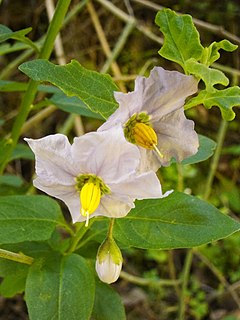
Solanum umbelliferum is a species of nightshade known commonly as bluewitch nightshade, or bluewitch. It can be found in chaparral habitat and low-elevation oak woodlands in California and parts of Baja California and Arizona. It is a small perennial herb or subshrub with dark gray-green oval-shaped leaves on hairy green stems that grow to a maximum height of one meter. It has bright purple or blue frilly flowers with thick yellow anthers at the center. The flowers close into spherical buds overnight. It bears small round green fruits which turn purple when ripe and resemble tiny eggplants.

Solanum elaeagnifolium, the silverleaf nightshade or silver-leaved nightshade, is a common weed of western North America and also found in South America. Other common names include prairie berry, silverleaf nettle, white horsenettle or silver nightshade. In South Africa it is known as silver-leaf bitter-apple or satansbos. More ambiguous names include "bull-nettle", "horsenettle" and the Spanish "trompillo". The plant is also endemic to the Middle East.
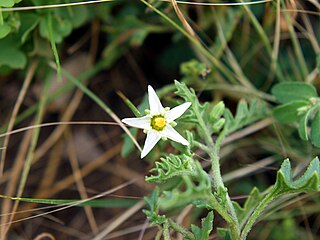
Solanum sarrachoides is a species of nightshade known as the hairy nightshade or leafy-fruited nightshade. In California, according to the Jepson Manual Solanum key, it is differentiated by its calyx (sepals) that are enlarged during fruit, but smaller when in flower.
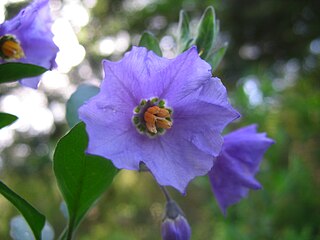
Solanum xanti, known commonly as chaparral nightshade, purple nightshade, and San Diego nightshade, is a member of the genus Solanum. It is native to the Western United States in Arizona, California, Nevada, and Oregon, and to northwest Mexico in Baja California.

Solanum physalifolium, known as hoe nightshade, Argentine nightshade, green nightshade and hairy nightshade, is a species in the family Solanaceae. Native to Argentina, Bolivia and Chile, it is widely naturalized in Australia, New Zealand, Europe, western Canada and the north western United States. Solanum physalifolium has been widely but incorrectly known as Solanum sarrachoides, a different species. It has been listed as a noxious weed in the US states of Kansas and Michigan under this misapplied name.

Solanum rostratum is a species of nightshade that is native to the United States and northern and central Mexico. Common names include buffalobur nightshade, buffalo-bur, spiny nightshade, Colorado bur, Kansas thistle, bad woman, Mexican thistle, and Texas thistle.

Lycianthes rantonnetii, the blue potato bush or Paraguay nightshade, is a species of flowering plant in the nightshade family Solanaceae, native to South America. Growing to about 6 ft (1.8 m) tall and broad, it is a rounded evergreen shrub with a somewhat lax habit. A profusion of trumpet-shaped, bright blue-purple flowers with a prominent yellow eye appear in summer, followed by red berries. It is widely cultivated and may be hardy in mild or coastal areas. Alternatively it can be grown in a container and brought under cover in winter. It requires a sheltered location in full sun. Though related to food plants like the potato and tomato, all parts of the plant are considered toxic to humans.
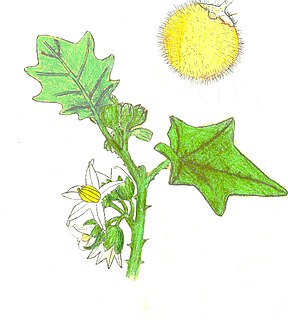
Solanum lasiocarpum, synonym Solanum feroxL., otherwise known as Indian nightshade or hairy-fruited eggplant, is a plant that produces edible fruit. Its flowers are white and its fruits are pale yellow.
Solanum dimidiatum is a species of plant in the family Solanaceae known by the common names western horsenettle, Torrey's nightshade, and robust horsenettle. It is native to the central United States, where it grows in many types of habitat, including disturbed areas. In California it is known as an introduced species and a noxious weed. It is a rhizomatous perennial herb producing an erect stem up to 80 centimeters tall. It is covered in yellow prickles and branched hairs. The leaves may be up to 15 centimeters long, their edges wavy to lobed and sometimes toothed. The inflorescence is a branching array of several flowers. Each flower has a bell-shaped corolla measuring 3 to 5 centimeters wide. It is lavender to purple, or white. The five large, yellow anthers are about a centimeter long. The fruit is a spherical yellow berry up to 3 centimeters wide.
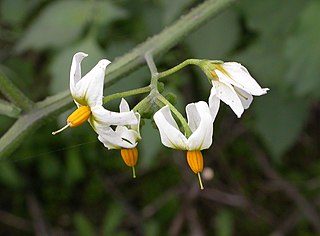
Solanum douglasii is a species of plant in the family Solanaceae known by the common name greenspot nightshade.

Solanum parishii is a species of nightshade known by the common name Parish's nightshade. It is native to western North America from Oregon to Baja California, where it grows in many types of habitat, including maritime and inland chaparral, woodlands, and forests. It is a perennial herb or subshrub producing a branching, ribbed or ridged stem up to about a meter in maximum height. The lance-shaped to nearly oval leaves are up to 7 centimeters long and smooth-edged or somewhat wavy. The inflorescence is an umbel-shaped array of several flowers, each borne on a short pedicel. The flower corolla is around 2 centimeters wide when fully open and is usually purple, but sometimes white. At the center are yellow anthers. The fruit is a berry roughly a centimeter wide.

Solanum triflorum is a species of nightshade known by the common names cutleaf nightshade and small nightshade. It is native to Argentina, but it is known on other continents, including Europe and Australia, as an introduced species and sometimes a weed. It is present throughout much of North America, where it is possibly non-native as well. It grows in many types of habitat, including disturbed areas. It is an annual herb producing spreading, decumbent stems up one meter long. It is hairy, the hairs sometimes associated with glands. The leaves are a few centimeters long and are deeply cut into toothlike lobes. The inflorescence bears two or three flowers each just under a centimeter wide when fully open. The flower is usually white, but is occasionally purple-tinged. The fruit is a berry roughly a centimeter wide.

Solanum diphyllum, commonly known as the twoleaf nightshade, is a species of nightshade native to the Americas. It is cultivated as an ornamental plant for its clusters of dark green round fruits that turn a bright yellow when ripe.

Solanum tampicense, also known as wetland nightshade, aquatic soda apple, and scrambling nightshade, is a perennial in the Solanaceae or Nightshade Family. It can exist as a vine, tree, or shrub and is native to the West Indies and Central America. It is classified as a noxious weed by the United States Department of Agriculture and by several states and is known as an invasive species in the state of Florida.

Solanum sandwicense is a rare species of flowering plant in the nightshade family known by the common names Hawai'i horsenettle and popolo 'aiakeakua. It is endemic to Hawaii, where it occurs today on the islands of Kauai and Oahu. It is threatened by the destruction and degradation of its habitat. It is a federally listed endangered species of the United States.

Solanum virginianum, also called Surattense nightshade, yellow-fruit nightshade, yellow-berried nightshade, Thai green eggplant, Thai striped eggplant, is also known as Indian night shade or yellow berried night shade plant, the common name is Kantakari, Solanumsurattense Brum. f. and Solanum xanthocarpum Schrad. and Wendl. are synonyms of Solanum virginianum L.. It is also a medicinal plant used mostly in India. Some part of the plant is poisonous ex. the fruit which is poisonous.



















